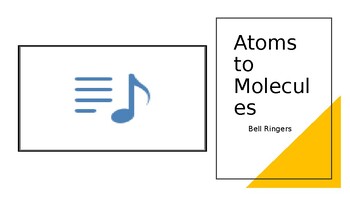Full Unit Bell Ringers- Unit 1-Atoms to Molecules
That Teacher Mom 307
11 Followers
Grade Levels
6th - 8th
Subjects
Standards
NGSSMS-PS1-4
NGSSMS-PS1-2
NGSSMS-PS1-5
NGSSMS-PS1-1
Formats Included
- PPTX
Pages
47 pages
That Teacher Mom 307
11 Followers
Description
Full Unit of "Bell Ringer" questions to be used at the beginning of each science lesson to introduce new topics or review previous topics.
Can be used in conjunction with the Full Unit Atoms to Molecules PowerPoint by ThatTeacherMom307.
Total Pages
47 pages
Answer Key
Included
Teaching Duration
2 months
Report this resource to TPT
Reported resources will be reviewed by our team. Report this resource to let us know if this resource violates TPT’s content guidelines.
Standards
to see state-specific standards (only available in the US).
NGSSMS-PS1-4
Develop a model that predicts and describes changes in particle motion, temperature, and state of a pure substance when thermal energy is added or removed. Emphasis is on qualitative molecular-level models of solids, liquids, and gases to show that adding or removing thermal energy increases or decreases kinetic energy of the particles until a change of state occurs. Examples of models could include drawings and diagrams. Examples of particles could include molecules or inert atoms. Examples of pure substances could include water, carbon dioxide, and helium.
NGSSMS-PS1-2
Analyze and interpret data on the properties of substances before and after the substances interact to determine if a chemical reaction has occurred. Examples of reactions could include burning sugar or steel wool, fat reacting with sodium hydroxide, and mixing zinc with hydrogen chloride. Assessment is limited to analysis of the following properties: density, melting point, boiling point, solubility, flammability, and odor.
NGSSMS-PS1-5
Develop and use a model to describe how the total number of atoms does not change in a chemical reaction and thus mass is conserved. Emphasis is on law of conservation of matter and on physical models or drawings, including digital forms, that represent atoms. Assessment does not include the use of atomic masses, balancing symbolic equations, or intermolecular forces.
NGSSMS-PS1-1
Develop models to describe the atomic composition of simple molecules and extended structures. Emphasis is on developing models of molecules that vary in complexity. Examples of simple molecules could include ammonia and methanol. Examples of extended structures could include sodium chloride or diamonds. Examples of molecular-level models could include drawings, 3D ball and stick structures, or computer representations showing different molecules with different types of atoms. Assessment does not include valence electrons and bonding energy, discussing the ionic nature of subunits of complex structures, or a complete depiction of all individual atoms in a complex molecule or extended structure.





